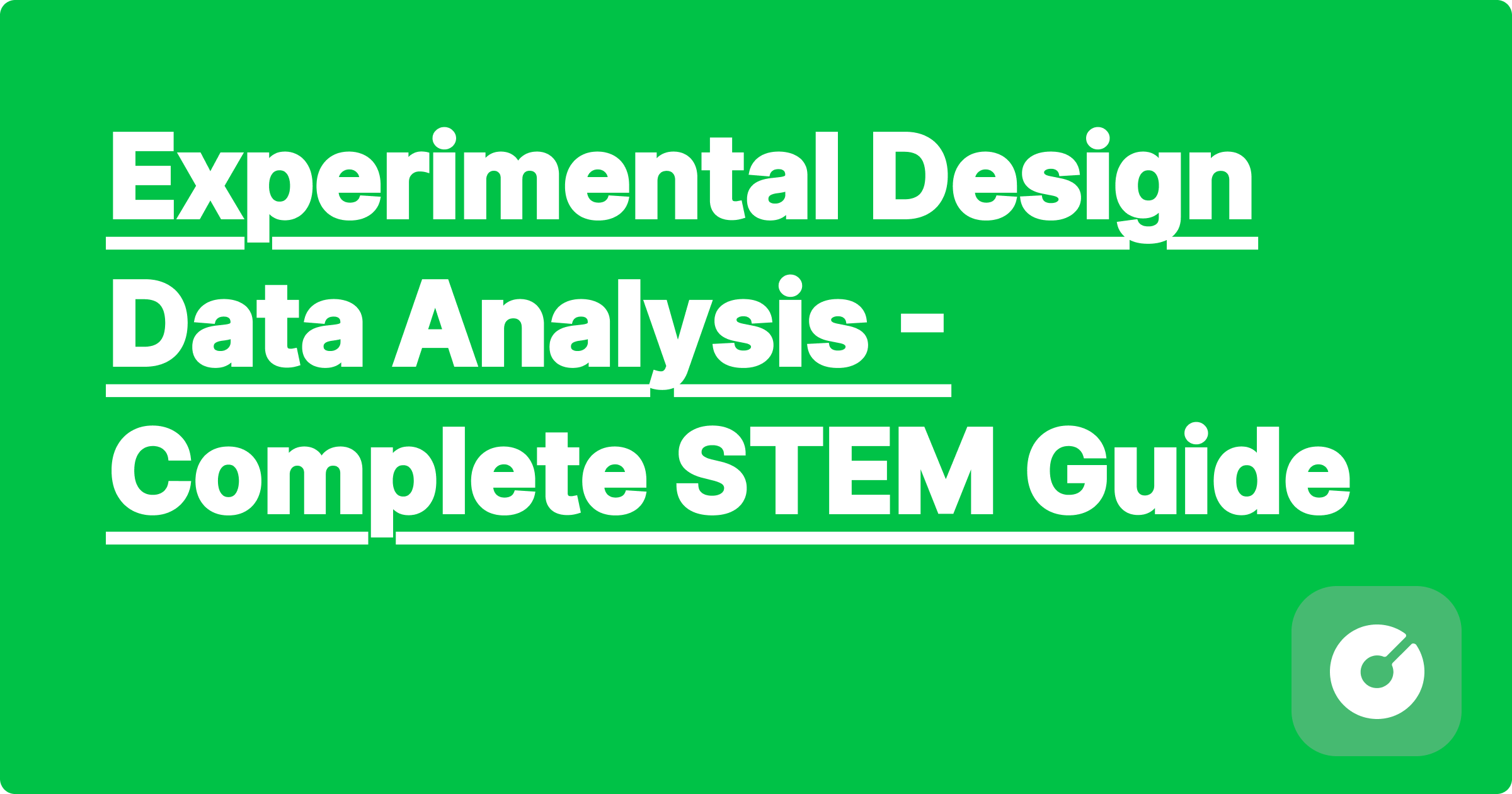## Decoding Experimental Design and Data Analysis: A STEM Student's Guide
**1. Engaging Introduction**
Ever wondered how groundbreaking discoveries in STEM fields are made? Behind every scientific breakthrough lies rigorous experimental design and meticulous data analysis. From developing a new drug to optimizing a renewable energy source, understanding how to design effective experiments and extract meaningful insights from data is crucial for any STEM professional. This post will equip you with the essential knowledge and practical skills to confidently navigate the world of experimental design and data analysis, setting you up for success in your studies and future career.
**2. Core Concepts Explanation**
Experimental design is the cornerstone of scientific inquiry. It's a structured approach to planning and conducting experiments to answer specific research questions while minimizing bias and maximizing the reliability of results. Key concepts include:
* **Hypothesis Formulation:** Clearly defining the research question and formulating testable hypotheses are the first steps. A hypothesis is a proposed explanation for an observation, which can be supported or refuted through experimentation. For example: "Increasing the concentration of fertilizer X will lead to a significant increase in the yield of crop Y."
* **Independent and Dependent Variables:** The independent variable is the factor manipulated by the researcher (e.g., fertilizer concentration), while the dependent variable is the outcome being measured (e.g., crop yield). Carefully controlling the independent variable and accurately measuring the dependent variable are essential.
* **Control Groups and Randomization:** A control group provides a baseline for comparison. Randomization ensures that experimental units are assigned to different treatment groups randomly, reducing bias and improving the generalizability of findings.
* **Experimental Design Types:** Different experimental designs cater to specific research questions. Common types include:
* **Completely Randomized Design (CRD):** The simplest design, where experimental units are randomly assigned to treatment groups.
* **Randomized Complete Block Design (RCBD):** Accounts for variability within blocks of experimental units that share similar characteristics.
* **Factorial Designs:** Investigate the effects of multiple independent variables and their interactions.
* **Latin Square Designs:** Control for row and column effects, useful in agricultural experiments or situations with spatial variation.
* **Data Analysis Techniques:** After data collection, appropriate statistical methods are employed to analyze the results. These methods depend on the type of data (continuous, categorical, etc.) and research question. Common techniques include:
* **t-tests:** Compare the means of two groups.
* **ANOVA (Analysis of Variance):** Compare the means of three or more groups.
* **Regression Analysis:** Model the relationship between independent and dependent variables.
* **Correlation Analysis:** Assess the strength and direction of the relationship between two variables.
* **Chi-square test:** Analyze categorical data to determine if there's a significant association between variables.
**3. Practical Examples and Case Studies**
Let's illustrate these concepts with examples:
**Case Study 1: Optimizing Solar Panel Efficiency**
**Research Question:** How does the angle of solar panel inclination affect energy output?
* **Independent Variable:** Angle of inclination (e.g., 0°, 15°, 30°, 45°)
* **Dependent Variable:** Energy output (kWh)
* **Experimental Design:** CRD – multiple solar panels are randomly assigned to different inclination angles.
* **Data Analysis:** ANOVA to compare the mean energy output across different angles.
**Case Study 2: Drug Efficacy Testing**
**Research Question:** Does a new drug effectively reduce blood pressure compared to a placebo?
* **Independent Variable:** Treatment group (drug or placebo)
* **Dependent Variable:** Blood pressure (mmHg)
* **Experimental Design:** RCBD – participants are grouped based on age and gender (blocks) and then randomly assigned to treatment groups within each block.
* **Data Analysis:** Two-sample t-test to compare the mean blood pressure reduction between the drug and placebo groups.
**4. Step-by-step Implementation Guide**
Here's a practical guide to implementing experimental design and data analysis:
1. **Define the Research Question:** Clearly articulate the problem you're trying to solve.
2. **Formulate Hypotheses:** Develop testable hypotheses based on your research question.
3. **Choose an Experimental Design:** Select the appropriate design based on your research question and available resources.
4. **Conduct the Experiment:** Carefully collect data, ensuring accuracy and minimizing bias.
5. **Data Cleaning and Preparation:** Clean your data, handle missing values, and transform variables as needed.
6. **Exploratory Data Analysis (EDA):** Visualize your data using histograms, scatter plots, etc., to identify patterns and outliers.
7. **Statistical Analysis:** Choose and apply appropriate statistical tests to analyze your data.
8. **Interpret Results:** Draw conclusions based on your statistical analysis and relate them back to your hypotheses.
9. **Report Findings:** Clearly communicate your results, including limitations and future research directions.
**5. Recommended Tools and Resources**
Several tools facilitate experimental design and data analysis:
* **Statistical Software:** R (with packages like `ggplot2`, `dplyr`, `tidyr`, `lme4`), Python (with libraries like `pandas`, `scikit-learn`, `statsmodels`, `matplotlib`, `seaborn`), SPSS, SAS, MATLAB. R and Python are particularly popular in academia and industry due to their open-source nature and extensive libraries.
* **Online Resources:** Khan Academy, Coursera, edX, and DataCamp offer valuable courses on statistics and data analysis.
* **Collaboration Platforms:** GitHub, GitLab, and Overleaf facilitate collaborative research projects.
**Example Code Snippet (R):** Performing a t-test
```R
# Sample data: blood pressure before and after treatment
before <- c(140, 150, 135, 160, 145)
after <- c(130, 140, 125, 150, 135)
# Perform a paired t-test
result <- t.test(before, after, paired = TRUE)
print(result)
```
**6. Conclusion and Next Steps**
Mastering experimental design and data analysis is crucial for success in any STEM field. By understanding the core concepts, utilizing appropriate tools, and practicing with real-world examples, you can confidently tackle complex research questions and contribute meaningfully to scientific advancement. As you progress, explore advanced statistical techniques like Bayesian analysis, machine learning for data analysis, and specialized experimental designs to further enhance your skillset. Continuous learning and practical application are key to building a strong foundation in this critical area, significantly boosting your career prospects in research, development, and engineering. Embrace the challenge, and you'll be well-equipped to unravel the mysteries of the scientific world.
Related Articles
Explore these related topics to enhance your understanding:
